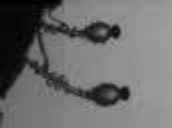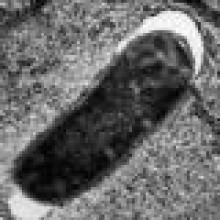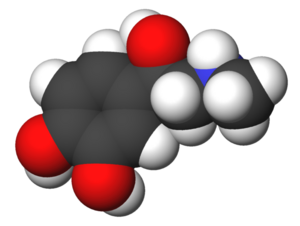In the NewsFlash this week, we discover the stem cells that allow muscle to grow and recover and progenitor cells which become body fat. Also, why Fungi fruiting bodies fire spores at super speed, and how to turn plants into petrol! Plus, we find out how to block bacteria from detecting the immune system, and so stop them from becoming virulent.
In this episode

Stem Cells Muscle In
Scientists have shown that, contrary to prevailing wisdom, muscles contain stem cells that can repair, replace and strengthen injured tissue. Writing in Nature Stanford researcher Helen Blau and her colleagues have identified a collection of chemical markers that can be used to identify a population of muscle stem cells.
 Dubbed "satellite cells" because these small round bodies usually loiter at the edges of muscles, when injected into an injured muscle they can rapidly begin to divide, producing more stem cells and new muscle tissue.
Dubbed "satellite cells" because these small round bodies usually loiter at the edges of muscles, when injected into an injured muscle they can rapidly begin to divide, producing more stem cells and new muscle tissue.
The team made the discovery by genetically labelling the cells with a coloured marker protein before injecting them into mice with damaged leg muscles. This technique enabled the researchers to follow the progress of the same mouse over a period of time by using a sensitive camera that could pick up the increasing intensity of the coloured stem cells as they grew.
"We were able to show that the injected cells increased their own numbers, contributed to existing muscle and also produced entirely new muscle in these mice," points out Blau. The results are very exciting because now researchers are able to readily identify the muscle stem cells they can turn their attention to discovering ways to activate them in people with muscle-wasting diseases, or use them to repair muscles in trauma patients.
"That's the next step," says Blau.

‘Baby’ Fat may Beat Obesity
It's something that many of us struggle with - fat. But where does it come from? Researchers in Dallas have finally tracked down the location of immature fat cells, which hide out waiting for the extra calories that turn them into flab.
For a while, researchers have suspected that immature fat cells, known as progenitors, were hiding in or around the blood vessels that feed fatty tissues, but their precise location wasn't known. Working with mice, the researchers engineered fat progenitor cells with a gene that makes them glow green, so they could be followed in the body. They discovered that the progenitor cells are embedded in the walls of blood vessels that run through fatty tissues, and are an integral part if the vessel wall.
The researchers think that the cells are there because it enables them to sense the levels of nutrients in the blood. When they get a whiff of excess calories, they can drift out of the blood vessels and mature into big fat cells.
The green label also meant that researchers could separate the immature fat cells from other cells, and grow them in the lab for further study. The team hopes that they will understand more about the mechanisms behind fat growth, which could lead to ways to cut obesity and metabolic diseases such as diabetes in the future.
As well as potentially helping people who struggle with their figure, the research could also point to ways to reactivate immature fat cells -for example, to fill in damaged tissues such as after injury or breast cancer surgery.
Fungi are world's fastest fliers
Scientists have discovered the fastest fliers in nature and, somewhat surprisingly, they're fungi!
 Ohio-based researcher Nicholas Money and his colleagues at Miami University made the discovery by using ultra-fast cameras capable of taking 250,000 frames per second. Down the lens they were studying members of two fungal families - the ascomycetes and the zygomycetes - that do the essential but unsalubrious job of breaking down animal dung. These fungi rely on their spores passing harmlessly through the guts of grazing animals so that they land, quite literally, in the remains of their lunch. But animals generally avoid grazing in areas where another animal has defaecated, leaving fungi like these with a problem. Their solution is to have evolved the mycological equivalent of a "super-soaker" squirt gun - they fire their spores from tiny fluid-filled fruiting bodies so that they land in patches of uncontaminated grass ready for the next browsing ruminant. But although scientists realised that the fungal launchpad must be incredibly powerful, it was too fast and too small to surrender its secrets, at least until now.
Ohio-based researcher Nicholas Money and his colleagues at Miami University made the discovery by using ultra-fast cameras capable of taking 250,000 frames per second. Down the lens they were studying members of two fungal families - the ascomycetes and the zygomycetes - that do the essential but unsalubrious job of breaking down animal dung. These fungi rely on their spores passing harmlessly through the guts of grazing animals so that they land, quite literally, in the remains of their lunch. But animals generally avoid grazing in areas where another animal has defaecated, leaving fungi like these with a problem. Their solution is to have evolved the mycological equivalent of a "super-soaker" squirt gun - they fire their spores from tiny fluid-filled fruiting bodies so that they land in patches of uncontaminated grass ready for the next browsing ruminant. But although scientists realised that the fungal launchpad must be incredibly powerful, it was too fast and too small to surrender its secrets, at least until now.
Writing in this weeks PLoS ONE the team have successfully made fungal ballistic measurements of spore trajectories to reveal that these organisms are firing their microscopic projectiles, which measure just a fraction of a millimetre across, at speeds exceeding 25 metres per second and at rates corresponding to 180,000 times the acceleration due to gravity. This is sufficient to propel the spores up to 2.5 metres away from the parent dung pile.
The team were also able to get a handle on how the organisms achieve their fungal feat. A concentrated mixture of sugars, alcohols and other metabolites inside the fungus and its fruiting body pulls in water by osmosis, priming the gun at a pressure about four times that of the atmosphere. At the right moment the structure ruptures and the pressure drives out the spores. According to the researchers the images of these fungal ejaculations are so pretty that they've set them to music and plan to post them on YouTube!

Plant Sugars Provide Petrol
We all know that the days of fossil fuels are limited, so researchers are trying to find alternative fuels. Biofuels have risen in popularity in recent years - fermenting plant material to make ethanol is already being used to produce fuel in several countries around the world. But ethanol is a long way, chemically speaking, from the petrol (or gasoline for our US listeners) and diesel that are currently used in car engines.
 The problem is that plant sugars have lots of oxygen atoms in them, which aren't found in fuels like gasoline. Now scientists at the University of Wisconsin-Madison have developed a biofuel that is identical, at the molecular level, to gasoline.
The problem is that plant sugars have lots of oxygen atoms in them, which aren't found in fuels like gasoline. Now scientists at the University of Wisconsin-Madison have developed a biofuel that is identical, at the molecular level, to gasoline.
Writing in the journal Science, the researchers have found a technique for turning complex plant sugars, called lignocellulose, into molecules that can be "upgraded" to make petrol, diesel and airplane fuel. They do this by turning the plant sugars into molecules with fewer oxygen atoms, which can then be converted into high octane gasoline.
To create the new fuels, the scientists add a solid catalyst to a solution of the plant sugars. After a reaction, an oil-like substance is produced, that can be skimmed off the top of the solution. In this oil are acids, alcohols, ketones and other molecules, which are the precursors to gasoline. They can then be used in further reactions to make gasoline.
This is a much more efficient way of using lignocellulose for biofuels than previous techniques - the oil created by the team retains around 90% of the energy content found in the original sugars. Although this technique is still at an experimental stage, it might be the key to solving the oil crisis in the future.

10:04 - Surprise Attack - Stopping Bacteria from Sensing your Immune Response
Surprise Attack - Stopping Bacteria from Sensing your Immune Response
Vanessa Sperandio, Southwestern Medical Centre, University of Texas
Chris - Some bacterial infections, like E. coli 0157 which is a cause of food poisoning and can also damage your kidneys, seem to get a lot worse when you give patients antibiotics, instead of getting better. It seems that this is because the bacteria enter a sort of high-alert state in response to the treatment. They fight back by becoming a lot more virulent. Researchers at the Southwestern Medical Centre, University of Texas have come up with a drug that can stop the bacteria from sensing the chemicals in your body that tell the bacteria your body's gearing up to fight them. Dr Vanessa Sperandio is in Dallas and she joins us to tell us a bit about this research. Hello...
Vanessa - Hello Chris.
 Chris - How do bacteria home into the fact that we're on to them?
Chris - How do bacteria home into the fact that we're on to them?
Vanessa - They sense two stress hormones that you have: adrenaline and noradrenaline, and they use those two hormones as cues to know they are inside of you. When they sense that through a receptor in the bacteria they activate production of the virulence trait. By doing that they can actually make you sick and turn on everything that will cause disease.
Chris - It's intriguing to think that these bacteria are eaves-dropping on our own inflammatory signals. They've learned or evolved, I should say, to detect the signals our body uses to fight them.
Vanessa - Yes, and those are very primal types of signals. That's at the core of your immune system and it's the core of gauging how well - how healthy or not you really are and how stressed you are.
Chris - How did you get a handle on what the bacteria were doing and then try to work out how to stop them?
Vanessa - We figured out many years ago that they were using the signals and then in 2006 we were able to identify one of the bacterial receptors for this signal. What we've done now is to develop drugs that will bind to the bacteria receptors and prevent the receptors from seeing the host's stress hormones. In this way the bacteria passes blindly through the host without being able to know where it is and activate it virulence traits.
Chris - So you've managed to come up with a drug molecule that can block up the ability of the bacteria to see adrenaline or noradrenaline so the bacteria don't effectively know they're in the body.
Vanessa - Yes.
Chris - How could this molecule be used and is it safe?
Vanessa - So far the molecule is safe. Of course, this is in the lab of proof of principle. We did do some preliminary toxicology in mice and so far it looks to be safe. It also does not signal to human adrenergic receptors, which is important. It can be used either to treat infections or hopefully we want to try to use this to prevent infections.
 Chris - Which sorts of bacteria will be vulnerable to this? You've done tests on a number of different classes of bacteria but where do you see it actually being most useful?
Chris - Which sorts of bacteria will be vulnerable to this? You've done tests on a number of different classes of bacteria but where do you see it actually being most useful?
Vanessa - It can be very useful for something like E. coli 0157 which, right now, has no treatment. We also did look at this drug to treat salmonella infections which can cause gastroenteritis and typhoid fever. We looked into tularaemia which is a bioterror agent. In between these bacteria there are several important pathogens that have this sensor. This could be used hopefully to treat some of the communal infections especially for patients in ventilators. Bacteria like klebsiella, acinetobacter, pseudomonas who are important in this class of patient'swhich do not have a lot of treatments and antibiotics against and are quite resilient to the biotic treatments. They all posses this signalling system.
Chris - When do you think that we might be seeing this going into humans in clinical trials?
Vanessa - We've got money from the National Institute of Health to develop this drug to pre-clinical in five years which means in five years we want to be able to have everything pre-clinically, toxicology and safety done. Hopefully in five years we'll start the first safe trials in humans.
Chris - Thank you Vanessa.
Related Content
- Previous Bugs, Bad Breath and Probiotics
- Next Superbugs - MRSA and C. diff









Comments
Add a comment